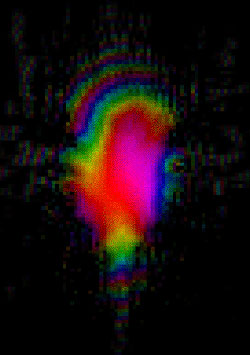Look Ma, No Electrons!

A team of researchers has conceived of a way to create what they call a “molecule without electrons.” In the 20 June PRL they describe a method using lasers to effectively create an attraction between two naked nuclei. If the method proves feasible, it could lead to new types of nuclear experiments and possibly a way to create controlled, small-scale nuclear fusion.
In a molecule, the positively-charged nuclei are shielded from one another by negative electron clouds, but without the electrons, the nuclear repulsion overwhelms any attempt to hold them close together. Still, accomplishing this feat could lead to precise control over nuclear reactions.
Misha Ivanov of the National Research Council in Ottawa and his colleagues describe a technique analogous to that of a street performer balancing a broom on her forehead. Even though gravity is always tipping the broom away from vertical, she can keep it up indefinitely. She constantly moves her head beneath the broom and repeatedly changes the direction in which it begins to fall. Ivanov and his colleagues’ theory involves a pair of lasers that continually jostle the nuclei around one another before they have a chance to separate. But unlike the street performer, this trick has a limited lifetime–the team expects the nuclei to fly apart after a few hundred femtoseconds.
The researchers propose using two lasers oriented at 90 degrees: a circularly polarized beam, which pushes charged particles in circles, and a linearly polarized beam, which pushes them back and forth along a line. If aimed at a proton and a deuteron–a nucleus made of a proton and a neutron–the lasers will cause the proton to orbit the deuteron, at least from the deuteron’s perspective. The proton’s path will rapidly trace out the surface of a cylinder. If the laser frequencies are high enough, the deuteron effectively feels the proton’s force in all directions, and the repulsion cancels itself.
This cancellation alone is not good enough, however. It turns out that the net force on the deuteron is–at best–zero everywhere inside the cylinder, which would still allow the nuclei to drift apart. The nuclear binding comes from additional, ephemeral forces that the street performer’s balancing act doesn’t require. Using equations and computer simulations, the team learned that if neither of the two laser frequencies is a multiple of the other, and if the intensities are right, the proton experiences enough extra motion to keep it bound to the deuteron. It’s as if the street performer could not balance the broom by simply moving her head around in a small horizontal circle; she also needs to add some sudden motions in random directions. But the simulations also show that even these extra motions cannot save the “molecule” from falling apart eventually.
Anthony Starace of the University of Nebraska at Lincoln is intrigued by the researchers’ proposal to smash the bound nuclei together with an addional laser pulse and trigger fusion. But he cautions that binding the nuclei in the first place might be a major technical challenge. The experiment requires high intensity lasers that can switch from zero to high power within five femtoseconds, says Ivanov, or else the nuclei would fly apart as the laser ramps up. That’s about twice as fast as currently available lasers can manage, but the experiment might be possible in a few years at the Advanced Laser Light Source being planned in Montreal.
–Kim Krieger
Kim Krieger is a freelance science writer in Norwalk, Connecticut.


